| Mar-01-08 | | Knight13: Draw? You don't know that... The final position should be draw I guess but who knows, one might get into Zugzwang. |
|
| Mar-12-09 | | WhiteRook48: Lasker already beat Marshall 8 to 0 |
|
Dec-21-09
 | | Phony Benoni: THe <American Chess Bulletin> for March, 1907, p. 46, gives a few additional moves as being played: <41.Ke2 Kc4 42.Ke3 Kd5 43.h4 Kc4 44.Ke4 h5 45.g3 Kc3 46.Ke3> ½-½ 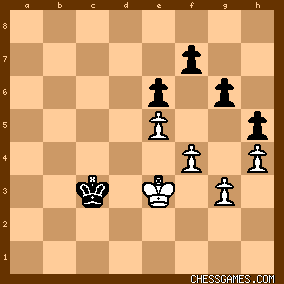
click for larger view
And now the draw looks much clearer.
http://books.google.com/books?id=3C... |
|
Dec-31-09
 | | GrahamClayton: I think Marshall erred in allowing a Queen swap after 18.♕c3 dc4 19.♕c4 ♕c4 20.♗c4 ♗c6+. 18...Bc6 exposing the White King to a possible pin along the d-file) might have been better. Seeing that Lasker was 3-0 ahead after 3 games, maybe Marshall's idea was to avoid another defeat at all costs? |
|
| Apr-03-16 | | RookFile: I'm sure that's right. When you lose a few in a row, a draw to steady yourself is not a bad idea. |
|
Nov-27-19
 | | KEG: In his excellent book on Lasker, Andrew Soltis divides the Lasker-Marshall 1907 World Championship match into three stages: (I) Games 1-3, in which Lasker raced out to a 3-0 lead; (II) Games 4-11 in which the contestants seemed well matched, in which Lasker won one game and drew the other seven, and in which Marshall had chances in several games; and (III) Games 12-15 in which a demoralized Marshall collapsed and got crushed in four consecutive games. The instant game (Game 4) was the beginning of Stage II. Marshall, as Black, obtained an edge in the opening and forced Lasker to work hard to earn the draw. The commentary on this game by Tarrasch was superb. His overall assessment of the game says it all: "Lasker's admirable genius shows itself in this game in the highest light. At a disadvantage from the beginning, he...made the best use of all his chances...placed the greatest difficulties in the path of his opponent, and...continually improved his own position." 1. e4 e6
Marshall played the French in all seven games in which he had Black in this match. His results were not great (four loses and three draws). But he got decent positions on several occasions, and the French itself was not the reason for Marshall's disastrous results. 2. d4 d5
3. Nc3 Nf6
Marshall never played the Winawer (3...Bb4) in this match, and all seven games in which Marshall had Black began with these moves. 4. Bg5
Lasker also played this in Games 6,8, and 10. He played 4. Bd3 in Games 2, 12, and 14. 4... Bb4

click for larger viewTarrasch claimed that this move (the MacCutcheon Variation) refutes 4...Bg5. Later analysis has not shared Tarrach's view: "This is a more aggressive continuation than 4...Be7 but one that allows White to make better use of his initiative. Although Black can soon get rid of the dangerous pin on his King's Knight he does so only at the cost of conceding the bishop pair." 5. e5
Perhaps because of his difficulties in this game, Lasker switched to 5. exd5 in Games 6, 8, and 10. Later opening commentary decided that 5. e5 is White's best here, although 5. exd5 is also playable. 5... h6
6. Bd2

click for larger viewThe assessment of this move changed over time. A contemporary commentary said of 6. Bd2: "This move leads to a drawn game. If White has no better move than this in prospect, then the policy adopted by Lasker in the second game [of the match] of avoiding this variation by playing 4. Bd3 instead of 4. Bg5 is preferable." (Guest) By contrast:
"!"--(Gligoric)
"This move which introduces the richest variations and which has given White good play in practice. Black's only active reply is to keep his King's Knight in the center, but in order to do so he just first part with his King's Bishop which could have been useful in the defense of his King-side." (Gligoric) 6... BxN
7. bxB
Citing Fischer-Petrosian, Curacao Candidate's Tournament 1962, Gligoric states that 7. BxB leaves Black with a good game. 7... Ne4
The thematic move for Black in the MacCutcheon.
8. Qg4

click for larger view"!"--(Gligoric")
"Always a good move in the French Defense, though many players would have hesitated to play this move before playing Bd3." (Gusst) "The disappearance of Black's minor pieces from the vicinity of his K-side makes things rather sensitive for him on that wing. The text move takes immediate advantage of Black's vulnerability and at the same time it helps White to complete his development." The alternatives to the text (8. Bd3 and 8. Bc1) present fewer problems for Black. |
|
Nov-27-19
 | | KEG: Post II
8... g6
Black cannot defend the g-pawn by castling because of 9. Bxh6., but the advance of the g-pawn creates a weakness which asserts itself to the very end of this game. The correct move is 8...Kf8." (Tarrasch). Th choice between 8...g6 and 8...Kf8 is critical but a close one. Gligoric says that "8...Kf8 is also considered to be good for White." But after his suggested 9. h4 (or 9. Bc1), Black gets a good game with 9...c5. Best for White after 8...Kf8 seems to be 9. Qf4 (or maybe just 9. Qd1) leading to a difficult struggle for both sides. Both Gligoric's and Marshall's 8...g6 and Tarrash's 8...Kf8 have their points. The game seems about even in either case. After 8...g6 the position was:

click for larger view9. Nf3
This closing of the retreating diagonal for the Queen can hardly be best, and reveals Lasker's lack of comfort in this variation (which may explain why he switched to 5. exd5 in his remaining games against the MacCutcheon in this match). 9. Bd3, 9. Bc1, 9. Qf4, 9. Qd1 or even 9. h4 all look better than the text. 9... c5!
"There is no better move for the second player." (Guest) The text is not only best but gave Marshall the better game: 
click for larger view10. dxc5
"White...ought hardly to have done [this] as the remaining Pawns on the Queen's wing will be left in an isolated condition." In response to such comments, Tarrasch wrote:
"At first glance this seems weak, but White doesn't have any choice. After other moves Black would get a good attack with ...Qa5." While Tarrash's overall assessment seems correct, he overstates his case by claiming that White "doesn't have any choice." He could also have played 10. Bd3 or perhaps 10. a4 or even 10. h4?! 10... Nd7
While the text is unobjectionable, I would have expected 10...Qa5 (or maybe 10...Qc7) from Marshall. 10...NxB was also a plausible choice here. 11. Bd3
The main alternative was 11. Bb5. I prefer Lasker's move, which left him in a difficult but hardly awful position: 
click for larger view11... NxB
"Again a bad exchange, as Marshall made so often during this match. The mistake lies in that Marshall brings White's King to the defense of the weak c-pawn and, what is worse, opens efficient lines for White's Queen and King's Bishop. 11...Ndxc5 was stronger." (Tarrasch) Tarrasch's analysis, as is nearly always the case, was both excellent but also an overstatement. 11...Ndxc5 was probably best for all the reasons Tarrasch indicates. But the text was hardly bad and left Marshall (after having been beaten in the first three games of the match) in position to achieve at least a draw. The position after 11...NxB was:
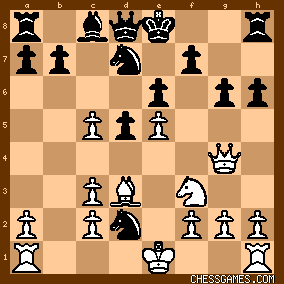
click for larger view12. KxN?
Although not discussed by any of the commentators, this was a mistake. Lasker should have gotten his Knight off the d1...g4 diagonal and gotten it into position for action on the Queen's-side with 12. NxN. In addition. 12. NxN would have allowed Lasker to play 12. 0-0 with reasonable chances. After the text, he got into serious trouble which he was able to sidestep only with remarkable defensive play. 12... Nxc5
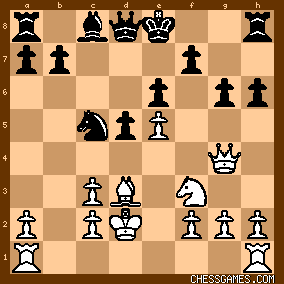
click for larger viewBy any reckoning, Marshall now had much the better position. |
|
Nov-27-19
 | | KEG: Post III
With his Queen-side pawn structure busted, Lasker had problems. It is interesting and instructive to see how Lasker addressed the difficulties of his position and worked his way to a draw. 13. Rhe1
Lasker decided to bring his Rook to e2. Other reasonable possibilities here were included 13. Ke2; 13. Qb4; and 13. Rhb1. 13... Bd7
14. Re3
From e3 the Rook defends the White Pawn on e5, and allows the possibility of operating horizontally (one of Lasker's great skills as he demonstrated in Game 1 of this match). 14... Qc7
A better way to play on the c-file was with 14...Rc8. After 14...Qc7, the position was:

click for larger view15. Rb1
"Threatening to sneak Rb1-b4-f4 [more horizontal Rook maneuvers] and then to sacrifice at g6 or f7." (Tarrasch). 15... 0-0-0
This can't be right. With Lasker having a Rook on the open b-file, Marshall's King should be going to the King-side. Lasker was seeking to attack there as well. But he had no open files (though Marshall's self-inflicted weakness on f6 must have been part of his thinking). 16. Qb4
Now that Marshall's King was situated on the Queen's wing, Lasker switched his attacking plans. This flexibility was part of Lasker's genius. 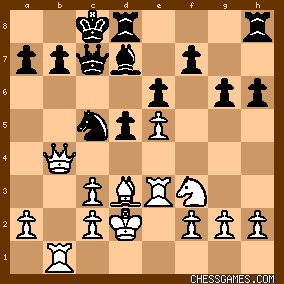
click for larger view16... Rhf8?
Defending against threats that no longer existed. Tarrasch said that the text "Threatens ...f5 followed by Ne4+." But Marshall should not have waited and should have played 16...Ne4+ immediately. 17. c4
"!"--(Moran)
"One must acknowledge the care with which Lasker works to improve his position. The move is fine but too risky." (Tarrasch). Tarrasch's delphic and seemingly contradictory comment expressed the situation quite accurately. The "safe" and perhaps theoretically correct move was 17. Ke1 (or 17. Ke2). But Lasker was likely fed up with his mangled Q-side pawn structure and decided to repair it even at the cost of giving Marshall dangerous count-chances. Fritz and Stockfish both hate Lasker's move. but I am closer to Moran and Tarrasch here. The position was now double-edged: 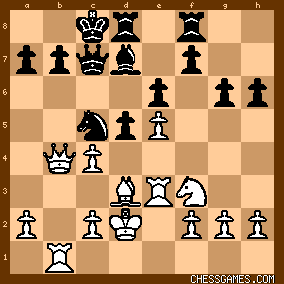
click for larger view17... Na6?
Missing his chance to seek to punish Lasker for his temerity with the simple 17...dxc4. 18. Qc3
18. Qa3 dxc4 19. Be2 looks much better and seems to allow Lasker to solve his problems. 18... dxc4
"I think that Marshall erred in allowing a Queen swap..." (GrahamClayton on this site). GrahamClayton prefers 18...Bc6, but Lasker could then have obtained a dangerou edge then with 19. c5! While GrahamClayton's analysis is usually excellent, here I must disagree. Marshall's game was fine after the text. GrahamClayton suggests that Marshall--who had lost the first three games of the match--may have sought refuge in the ending "to avoid defeat at all costs." RookFile in this comment on this site shares this view. More likely, Marshall simply found the best move. In general, running into the ending against Lasker (one of the finest endgame players of all time) without a good reason for doing so was a recipe for disaster. Moreover, as will be seen, the text didn't necessarily lead to a Queen trade. After 18...dxc4, the position was:

click for larger view19. Qxc4
19. Bxc4 was more accurate. As a theoretical matter, the endgame favored Marshall. 19... QxQ
20. BxQ Bc6+
21. Ke1

click for larger view |
|
| Nov-28-19 | | sudoplatov: This match shows how much better Lasker was than the "Rest of the World." (Also the Lasker match.) Marshall hung around as about #4 from 1904 to 1924, not a bad run. Lasker, Capablanca, Tarrasch, and Alekhine were consistently better. Somewhere I read a comment that Lasker picked Marshall as an easy opponent. However, Marshall's record around this time shows him as good a challenger as any. 1904 Cambridge Springs #1 (12-0-4)
1904 Sylvan Beach #1 (6-0-0) No real opposition.
1904 7th American Chess Congress #1 (8-0-1)
1905 Marshall-Janowski (8-5-4)
1905 Ostend #7-9 (8-9-9)
1905 Scheveningen #1 (11-1-1)
1905 Tarrasch-Marshall (1-8-8)
1906 Nuremberg #1 (9-0-7)
1907 Lasker-Marshall (0-8-7)
1907 Ostend #3-4 (8-5-7)
1907 Karlsbad #8 (6-6-8)
1907 Janowski-Marshall (2-5-3)
1908 Vienna #11 (8-7-4)
1908 Prague #10 (6-3-10)
1908 Dusseldorf #1 (8-0-7)
1908 Lodz #2 (out of 3) (4-4-8)
1908 Rubenstein-Marshall (2-3-3)
1908 Marshall-Mieses (5-4-1)
1909 Marshall-Jaffe (4-2-3)
1909 Capablanca-Marshall (8-1-14)
1909 New York State #2 (3-1-1) Neither Marshall nor Jaffe won
1909 Marshall-Showalter (7-2-3)
1910 Hamburg #5-6 (7-4-5)
1910 New York Masters #1 (8-0-4) Capablanca #2
1911 San Sebastian #4 (4-1-9)
1911 Karlsbad #5-6 (10-4-11)
1912 San Sebastian #6 (7-6-7)
1912 Bad Pistyan #3 (7-3-8)
1912 DSB #5 (7-5-5)
1912 Marshall-Janowski (6-2-2)
1913 American National #2 (8-0-5)
Lasker seems only to have missed out on matches due to illness (of opponents like Tarrasch) or lack of money. Who was Marshall's travel agent? |
|
Nov-28-19
 | | keypusher: < sudoplatov: This match shows how much better Lasker was than the "Rest of the World." (Also the Lasker match.) Marshall hung around as about #4 from 1904 to 1924, not a bad run. Lasker, Capablanca, Tarrasch, and Alekhine were consistently better. Somewhere I read a comment that Lasker picked Marshall as an easy opponent. However, Marshall's record around this time shows him as good a challenger as any.> Come again?
<1905 Tarrasch-Marshall (1-8-8)>
<1909 Capablanca-Marshall (8-1-14)> If Marshall had beaten Lasker, people at the time wondered if it would be proper to recognize him as WC, given the Tarrasch match. To be fair, no one thought of Capablanca as a contender in 1907; it was the Marshall match and San Sebastian (1911) that put him on the map. But don't forget about Geza Maroczy and Carl Schlechter: https://www.chessgames.com/perl/che... http://www.chessmetrics.com/cm/CM2/... And say hello to Akiba Rubinstein, though 1907 was a bit early for him. Karlsbad (1907) Also, Tarrasch faded after 1907, so I don't know if it would be right to say that he was consistently better than Marshall. Certainly by the 1920s he was a lot worse. |
|
Nov-28-19
 | | perfidious: Yeah, the sea air swung the balance in Tarrasch-Lasker; hadn't been for that, maybe Lasker wins by two points instead of five. (rolls eyes) It cannot be denied that Marshall was a fine tournament player, but as was the case with fellow optimists Bogoljubov and Larsen, he came in for a most severe beating at the hands of the very greatest match players. |
|
Nov-28-19
 | | KEG: <keypusher>It was indeed surprising that Marshall and not Tarrasch was Lasker's challenger. Putting aside financial and personal considerations (Lasker and Tarrasch detested each other), the only even arguable reasons to support defending the title against Marshall rather than Tarrasch in 1907 were: (a) Marshall was the only player to finish ahead of Lasker in a tournament between 1895 and the time of the match; (b) Marshall had a winning record against Lasker (one win and one draw); and (c) Marshall had finished first at Nuremberg 1906 while Tarrasch had finished tied for 9th-11th with a negative score. Against that, and even ignoring Tarrash's fantastic tournament record through 1898 (including his fist place at Vienna 1898): (i) Tarrasch had demolished Marshall in their 1905 match eight games to one; (ii) Tarrasch had finished far ahead of Marshall at Ostend 1905, Tarrasch tying for 2nd place with Janowski behind only Maroczy while Marshall finished tied for 7th-9th with a negative score; (iii) Tarrasch had won at Monte Carlo 1903 ahead of Maroczy, Pillsbury, Schlechter and Teichmann while Marshall (with a negative score) finished 9th. Directly after the Lasker-Marshall match, Tarrasch again demonstrated his superiority in winning the Ostend 1907 match tournament in which Marshall tied for 3rd-4th and in which Tarrasch won his mini-match against Marshall (with one win and three draws). According to Andrew Soltis in his book on Marshall, the result in the Tarrasch-Marshall 1905 was farther beyond the expected result (Tarrasch would be expected to have been 2-3 games ahead of Marshall in a 17 game match rather than the actual 7 game margin) than any 20th century matches other than Alekhine-Euwe 1935 abd Alexandria-Levitina 1983). But even if Elo's analysis is correct, Tarrasch was clearly superior to Marshall in 1905. Had Marshall somehow won his match against Lasker, he could not have been deemed the world's best. This, of course, was never going to happen, since Marshall was not in Lasker's class, and indeed won only one further game against Lasker in 1940 (when Lasker was too ill even to finish the match). I also agree that Tarrasch faded after 1907. I suspect that Lasker would probably have won a match against Tarrasch during the period 1895-1907 had such a match taken place. I also suspect that Lasker would probably have defeated Pillsbury or Maroczy had either of these fine players been given a title shot. But, since Lasker failed to defend his title between 1896 and 1907, we will never know. Lasker's failure to defend his title against his top competitors (Tarrasch, Pillsbury, and Maroczy) is the one major blemish on his otherwise fabulous chess career. |
|
Nov-28-19
 | | KEG: Post IV (on Game 4 of the match)
Marshall was still better after 21. Ke1. But matters soon went downhill for him from here and he had to settle for a draw. 21... BxN
"Another bad exchange. Marshall gives up the well placed Bishop for the much weaker Knight. After 21...Nc5, Black would have winning chances." Such fine analysis by Tarrasch confirms the belief of <keypusher> and <perfidious> that Tarrasch would have been a better challenger than Marshall in 1907 and that the result of Lasker's 1908 match with Tarrasch obscures the true relative strength of these two immortals. After 21...BxN, perhaps the most interesting position in the game was presented: 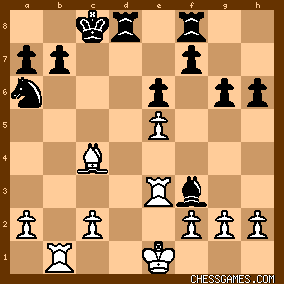
click for larger view22. RxB
One contemporary commentator contended that Lasker might even have had winning chances here with 22. BxN. More recent commentary (Moran) tends to refute any claim that Lasker could have obtained any advantage (let alone winning chances) with 22. BxN. e.g., 22...Bxg2 [Guest and Moran only consider this move. In fact Black could have obtained better chances with 22...Bd5. But even after 22...Bxg2, Black stands slightly better) 23. f3 and now: (A) 23...Rd7 (Best), a move overlooked by Moran but found decades earlier by Guest which leaves Black better situated: (B) 23...bxB (Moran's move, which Guest--mistakenly in my view--thought would leave Lasker with winning chances) 24. Rc3+ Kd7 25. Rb7+ Ke8 26. Rcc7 (26. Kf2 immediately also leads to equality) Rd5 27. Kf2 leads to equality. But here Guest's analysis falls apart since he only considers 27...Bh3?? which loses to 28. c4 and overlooks the equalizing 27...Bh1. Guest then compounds his error by having White play not 28. c4 but 28. Rxa7 which should lead to a draw after 28...Kd8. The balance of his analysis (which I will not present) is also bad. In sum there was nothing wrong with Lasker's 22. RxB, which was probably best play, after which the position was: 
click for larger view22... Nc5
"Black still stands better, but the counter attack on his f-pawn, combined with Lasker's exemplary endgame play, is sufficient to secure White the draw." (Tarrasch) Yet another instructive comment by Tarrasch that yet again makes me long to have seen Tarrasch as the challenger in 1907 rather than Marshall. 23. b5
"!"--(Tarrasch)
23... b6
24. Rb4

click for larger view"Lasker has cleverly prevented Black from playing Rd4 (which would have been the answer to 23. Rb4) because of 25. Bh6+. In retrospect, White's Rook moves seem unusually simple, but to find them in the heat of battle was another matter." Once again, Tarrasch's commentary says it all.
24... Rd7
25. Be2
25. Bd3 looks better.
25... Kd8

click for larger view"Doubling Rooks would be useless because White would rely 26. Rbf4 [26. h4 is an interesting alternative--KEG] and after Rd2 27. Rc3 [or 27. Rc4--KEG] then the Rook at d2 must retreat of be locked in by Bd3. Therefore Marshall wants to come to the aid of his f-pawn with his King, which, however, Lasker hinders." (Tarrasch) |
|
Nov-28-19
 | | KEG: Post V
26. Bb5 Rd5
26...Rc7, combining defense of his second rank as well as creating threats on the c-file was better. 27. Re3
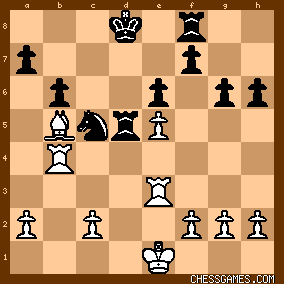
click for larger view27... Kc7
"27...Ke7 would lose a Pawn to 28. Bb6 Rdd8 29. Ra3." (Tarrasch) A rare oversight in analysis by Tarrasch (which was later uncritically repeated by Moran). 27...Ke7 would indeed create serious problems for Black after 28. Ba6, but Tarrasch's 28...Rdd8? is a blunder. Black could offer stiffer resistance with 28...Na6 (e.g., 29. Ra4 Ra5 30. RxR bxR 30. Rd3 and White certainly had the better position, but far from a winning one). 28. Rf4 a6
28...g5 is an interesting alternative.
29. Bc4 Rd7
29...g5 was Marshall's last chance to play for a win. 30. Be2

click for larger view30... b5
Marshall seems to have been losing the thread of the game here. 30...f5 (or maybe 30...Rd5) were better. 31. Rb4
31. a3 was more accurate.
31... Kb6?

click for larger viewNow, as apparently only Tarrasch spotted, Lasker--who had been laboring to defend an inferior position--suddenly had winning chances. Marshall should have played 31...Rfd8 or 31...g5. 32. a3?
"Excessive caution. 33. c4 would have given White winning chances." (Tarrasch). 32... Rfd8
33. c4
Too late!
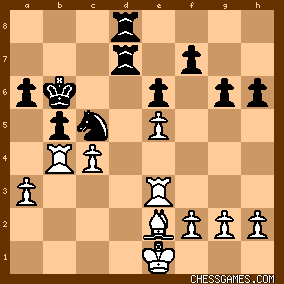
click for larger view33... Nd6+
"Which move, by bringing about exchanges, draws the game." (Guest) 34. BxN RxB
35. RxR RxR
36. cxb5
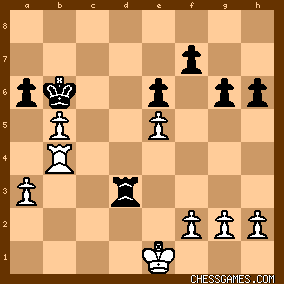
click for larger view36... axb5
"An attempt to win by 36...a5 would fail [i.e., still lead to a draw--KEG[ after 37. Rf4 Rxa3 38. Rxf7 Rb3 [38...Ra4 or 38...Kxb5 are perhaps simpler ways to draw--KEG] 39. Rf6 a4 [or 39...Kxb5] 40. Rxe6+ Kxb5 41. Re8 a3 [41...Kc6 was simpler] 42. Ra8." (Tarrasch) The final position in Tarrasch's fascinating analysis is: 
click for larger viewThis is still likely a draw, but Marshall was quite correct to avoid these nasty complications and head for the draw with 36...axb5, which left the position as follows: 
click for larger view |
|
Nov-28-19
 | | KEG: Post VI
From this point, a draw was almost inevitable:
37. a4 Rd5
38. f4
He might just as well have played 38. Rxb5+ immediately. 38... Ka5
39. Rxb5+ RxR
40. axR Kxb5
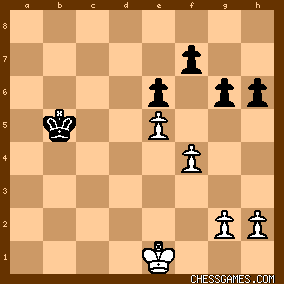
click for larger viewThis was the final position according to the score on this site. Indeed, the game could well have been abandoned as a draw at this point. But <Phony Benoni>, providing the benefits of his always enlightening research, has provided the remaining moves of the game: 41. Kf2 Kc4
42. Ke3
Forced! (Even as simple an endgame as this one can be ruined through careless play). 42... Kd5
43. h4
Trying to make something of nothing. 43. Kd3 or 43. g3 were simpler ways to terminate proceedings. 43... Kc4
45. g3 Kc3
46. Ke3
Forced but obvious.

click for larger view1/2--1/2 |
|
|
|
|





































